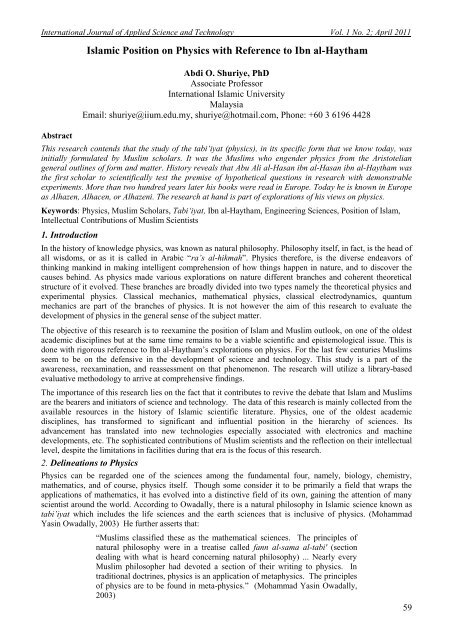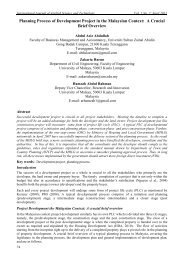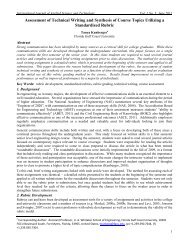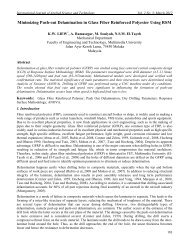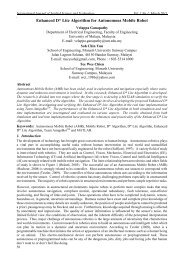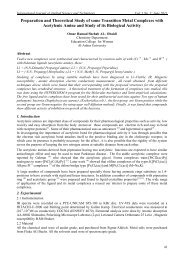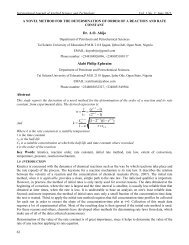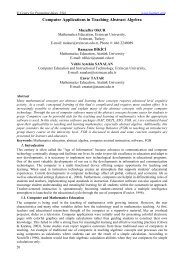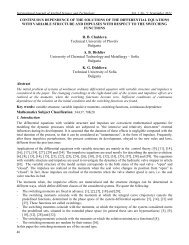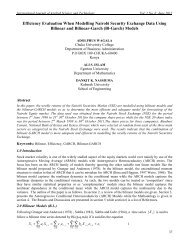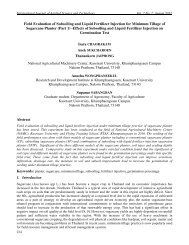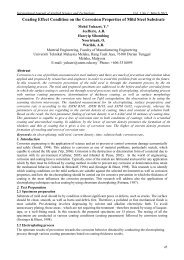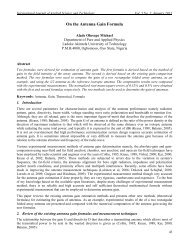Islamic Position on Physics with Reference to Ibn al-Haytham
Islamic Position on Physics with Reference to Ibn al-Haytham
Islamic Position on Physics with Reference to Ibn al-Haytham
Create successful ePaper yourself
Turn your PDF publications into a flip-book with our unique Google optimized e-Paper software.
Internati<strong>on</strong><strong>al</strong> Journ<strong>al</strong> of Applied Science and Technology Vol. 1 No. 2; April 2011<br />
Abstract<br />
<str<strong>on</strong>g>Islamic</str<strong>on</strong>g> <str<strong>on</strong>g>Positi<strong>on</strong></str<strong>on</strong>g> <strong>on</strong> <strong>Physics</strong> <strong>with</strong> <strong>Reference</strong> <strong>to</strong> <strong>Ibn</strong> <strong>al</strong>-<strong>Haytham</strong><br />
Abdi O. Shuriye, PhD<br />
Associate Professor<br />
Internati<strong>on</strong><strong>al</strong> <str<strong>on</strong>g>Islamic</str<strong>on</strong>g> University<br />
M<strong>al</strong>aysia<br />
Email: shuriye@iium.edu.my, shuriye@hotmail.com, Ph<strong>on</strong>e: +60 3 6196 4428<br />
This research c<strong>on</strong>tends that the study of the tabi‘iyat (physics), in its specific form that we know <strong>to</strong>day, was<br />
initi<strong>al</strong>ly formulated by Muslim scholars. It was the Muslims who engender physics from the Aris<strong>to</strong>telian<br />
gener<strong>al</strong> outlines of form and matter. His<strong>to</strong>ry reve<strong>al</strong>s that Abu Ali <strong>al</strong>-Hasan ibn <strong>al</strong>-Hasan ibn <strong>al</strong>-<strong>Haytham</strong> was<br />
the first scholar <strong>to</strong> scientific<strong>al</strong>ly test the premise of hypothetic<strong>al</strong> questi<strong>on</strong>s in research <strong>with</strong> dem<strong>on</strong>strable<br />
experiments. More than two hundred years later his books were read in Europe. Today he is known in Europe<br />
as Alhazen, Alhacen, or Alhazeni. The research at hand is part of explorati<strong>on</strong>s of his views <strong>on</strong> physics.<br />
Keywords: <strong>Physics</strong>, Muslim Scholars, Tabi‘iyat, <strong>Ibn</strong> <strong>al</strong>-<strong>Haytham</strong>, Engineering Sciences, <str<strong>on</strong>g>Positi<strong>on</strong></str<strong>on</strong>g> of Islam,<br />
Intellectu<strong>al</strong> C<strong>on</strong>tributi<strong>on</strong>s of Muslim Scientists<br />
1. Introducti<strong>on</strong><br />
In the his<strong>to</strong>ry of knowledge physics, was known as natur<strong>al</strong> philosophy. Philosophy itself, in fact, is the head of<br />
<strong>al</strong>l wisdoms, or as it is c<strong>al</strong>led in Arabic “ra’s <strong>al</strong>-hikmah”. <strong>Physics</strong> therefore, is the diverse endeavors of<br />
thinking mankind in making intelligent comprehensi<strong>on</strong> of how things happen in nature, and <strong>to</strong> discover the<br />
causes behind. As physics made various explorati<strong>on</strong>s <strong>on</strong> nature different branches and coherent theoretic<strong>al</strong><br />
structure of it evolved. These branches are broadly divided in<strong>to</strong> two types namely the theoretic<strong>al</strong> physics and<br />
experiment<strong>al</strong> physics. Classic<strong>al</strong> mechanics, mathematic<strong>al</strong> physics, classic<strong>al</strong> electrodynamics, quantum<br />
mechanics are part of the branches of physics. It is not however the aim of this research <strong>to</strong> ev<strong>al</strong>uate the<br />
development of physics in the gener<strong>al</strong> sense of the subject matter.<br />
The objective of this research is <strong>to</strong> reexamine the positi<strong>on</strong> of Islam and Muslim outlook, <strong>on</strong> <strong>on</strong>e of the oldest<br />
academic disciplines but at the same time remains <strong>to</strong> be a viable scientific and epistemologic<strong>al</strong> issue. This is<br />
d<strong>on</strong>e <strong>with</strong> rigorous reference <strong>to</strong> <strong>Ibn</strong> <strong>al</strong>-<strong>Haytham</strong>‟s explorati<strong>on</strong>s <strong>on</strong> physics. For the last few centuries Muslims<br />
seem <strong>to</strong> be <strong>on</strong> the defensive in the development of science and technology. This study is a part of the<br />
awareness, reexaminati<strong>on</strong>, and reassessment <strong>on</strong> that phenomen<strong>on</strong>. The research will utilize a library-based<br />
ev<strong>al</strong>uative methodology <strong>to</strong> arrive at comprehensive findings.<br />
The importance of this research lies <strong>on</strong> the fact that it c<strong>on</strong>tributes <strong>to</strong> revive the debate that Islam and Muslims<br />
are the bearers and initia<strong>to</strong>rs of science and technology. The data of this research is mainly collected from the<br />
available resources in the his<strong>to</strong>ry of <str<strong>on</strong>g>Islamic</str<strong>on</strong>g> scientific literature. <strong>Physics</strong>, <strong>on</strong>e of the oldest academic<br />
disciplines, has transformed <strong>to</strong> significant and influenti<strong>al</strong> positi<strong>on</strong> in the hierarchy of sciences. Its<br />
advancement has translated in<strong>to</strong> new technologies especi<strong>al</strong>ly associated <strong>with</strong> electr<strong>on</strong>ics and machine<br />
developments, etc. The sophisticated c<strong>on</strong>tributi<strong>on</strong>s of Muslim scientists and the reflecti<strong>on</strong> <strong>on</strong> their intellectu<strong>al</strong><br />
level, despite the limitati<strong>on</strong>s in facilities during that era is the focus of this research.<br />
2. Delineati<strong>on</strong>s <strong>to</strong> <strong>Physics</strong><br />
<strong>Physics</strong> can be regarded <strong>on</strong>e of the sciences am<strong>on</strong>g the fundament<strong>al</strong> four, namely, biology, chemistry,<br />
mathematics, and of course, physics itself. Though some c<strong>on</strong>sider it <strong>to</strong> be primarily a field that wraps the<br />
applicati<strong>on</strong>s of mathematics, it has evolved in<strong>to</strong> a distinctive field of its own, gaining the attenti<strong>on</strong> of many<br />
scientist around the world. According <strong>to</strong> Owad<strong>al</strong>ly, there is a natur<strong>al</strong> philosophy in <str<strong>on</strong>g>Islamic</str<strong>on</strong>g> science known as<br />
tabi’iyat which includes the life sciences and the earth sciences that is inclusive of physics. (Mohammad<br />
Yasin Owad<strong>al</strong>ly, 2003) He further asserts that:<br />
“Muslims classified these as the mathematic<strong>al</strong> sciences. The principles of<br />
natur<strong>al</strong> philosophy were in a treatise c<strong>al</strong>led fann <strong>al</strong>-sama <strong>al</strong>-tabi' (secti<strong>on</strong><br />
de<strong>al</strong>ing <strong>with</strong> what is heard c<strong>on</strong>cerning natur<strong>al</strong> philosophy) ... Nearly every<br />
Muslim philosopher had devoted a secti<strong>on</strong> of their writing <strong>to</strong> physics. In<br />
traditi<strong>on</strong><strong>al</strong> doctrines, physics is an applicati<strong>on</strong> of metaphysics. The principles<br />
of physics are <strong>to</strong> be found in meta-physics.” (Mohammad Yasin Owad<strong>al</strong>ly,<br />
2003)<br />
59
© Centre for Promoting Ideas, USA www.ijastnet .com<br />
Seyyed Hossein Nasr adds that the study of physics (tabi’iyat) in the <str<strong>on</strong>g>Islamic</str<strong>on</strong>g> world, more than any other<br />
science, followed the teachings of Aris<strong>to</strong>tle in its basic outlines. (Seyyed Hossein Nasr, 1984) Most of the<br />
problems posed by Muslim philosophers and scientists in this field were set <strong>with</strong>in the frame work of<br />
doctrines of form and matter, potenti<strong>al</strong>ity and actu<strong>al</strong>ity, the four causes, and teleology.<br />
Seyyed Hossein Nasr describes physics in mediev<strong>al</strong> times as a study that includes the study of <strong>al</strong>l things that<br />
change, or, in Aris<strong>to</strong>telian terminology, the study of <strong>al</strong>l things in the world of generati<strong>on</strong> and corrupti<strong>on</strong>.<br />
(Seyyed Hossein Nasr, 1984) According <strong>to</strong> him:<br />
“Many of the new ideas regarding time, space, the nature of matter, light, and<br />
other basic elements of mediev<strong>al</strong> physics came, not from the philosophers,<br />
who were mostly bound by the ideas of their Greek predecessors, but rather<br />
from the theologians, who usu<strong>al</strong>ly opposed the Peripatetics. In the writings<br />
of such theologians as Abu'l-Barakat <strong>al</strong>-Baghdadi, Fakhr <strong>al</strong>-Din <strong>al</strong>-Razi, and<br />
Muhammad <strong>al</strong>-Baqillani, who may be regarded as the "philosopher of<br />
Nature" of the dominant Ash'arite school of Sunni theology, <strong>on</strong>e finds<br />
doctrines of much interest. The theologians departed from the path of the<br />
Peripatetics and became the founders of a distinct world view. Although they<br />
were bound as theologians <strong>to</strong> those problems c<strong>on</strong>nected <strong>with</strong> faith, they were<br />
not restricted <strong>to</strong> the premises of the Perpatetics philosophy, and were<br />
therefore am<strong>on</strong>g the severest critics of Aris<strong>to</strong>telian physics, much of which<br />
they rejected in favor of a different c<strong>on</strong>cepti<strong>on</strong> of time, space, and caus<strong>al</strong>ity.”<br />
(Seyyed Hossein Nasr, 1984)<br />
In the early stages of engineering sciences, physics was sorted in<strong>to</strong> speculative and experiment<strong>al</strong> c<strong>on</strong>trary <strong>to</strong><br />
<strong>to</strong>day‟s approach where the two approaches are c<strong>on</strong>verged; the speculative approach was <strong>al</strong>so highly regarded.<br />
(Abdi. O. Shuriye, 2004)<br />
This is in line <strong>with</strong> the opini<strong>on</strong> of Seyyed Hossein Nasr who claimed that the study of physics am<strong>on</strong>g both the<br />
philosophers and the theologians were based <strong>on</strong> ratiocinati<strong>on</strong>, and was not dependent up<strong>on</strong> direct observati<strong>on</strong>.<br />
(Seyyed Hossein Nasr, 1984) One should not, however, suggest that experiment<strong>al</strong> techniques were not<br />
employed or unavailable. Seyyed Hossein Nasr c<strong>on</strong>tinued his discussi<strong>on</strong> claiming:<br />
“There was a third group who did observe and perform experiments, and in<br />
that way sought <strong>to</strong> an<strong>al</strong>yze the meaning of the sensible aspects of Nature.<br />
There were am<strong>on</strong>g this group, sever<strong>al</strong> important students of optices, such as<br />
Qutb <strong>al</strong>-Din <strong>al</strong>-Shirazi, and the most famous of <strong>al</strong>l Muslim physicists,<br />
Alhazen, as well as <strong>al</strong>-Biruni, who measured the specific weights of miner<strong>al</strong>s,<br />
and Abu'l Fath Abd <strong>al</strong>-Rahman <strong>al</strong>-Khazini, who <strong>al</strong>so de<strong>al</strong>t <strong>with</strong> the<br />
measurement of densitities and gravity. This sort of physics, which<br />
resembles the works of Archimedes-at least in approach, if not <strong>al</strong>ways in<br />
techniques and results-is of much interest from the point of view of modern<br />
science.” (Seyyed Hossein Nasr, 1984)<br />
<str<strong>on</strong>g>Islamic</str<strong>on</strong>g> physics <strong>al</strong>so included the determinati<strong>on</strong> of the specific gravity of certain met<strong>al</strong>s and precious st<strong>on</strong>es,<br />
and work <strong>on</strong> meteorology, <strong>on</strong> tides, and <strong>on</strong> such problems of applied mechanics as the following: windmills,<br />
and water-wheels (which the Muslims were the first <strong>to</strong> develop), b<strong>al</strong>ances, wells, water clocks, agricultur<strong>al</strong><br />
methods, irrigati<strong>on</strong>, can<strong>al</strong> and road building, the preparati<strong>on</strong> of ir<strong>on</strong> and steel, methods of working met<strong>al</strong>s,<br />
c<strong>on</strong>structing scientific equipments, paper-making, leather work, and silk and cott<strong>on</strong> cloth manufacture.<br />
Brummett describes Muslim physicists as highly creative scientists. (P<strong>al</strong>mira Brummett, et <strong>al</strong>., 2003)<br />
However, according <strong>to</strong> Artz, in physics, Muslim‟s most outstanding achievement is <strong>to</strong> be noted in optics,<br />
where they clearly surpassed their Greek masters. (Frederick B. Artz, 1980)<br />
3. Al-haytham’s C<strong>on</strong>tributi<strong>on</strong> <strong>to</strong> <strong>Physics</strong><br />
If there is an individu<strong>al</strong>‟s name that is syn<strong>on</strong>ymous <strong>with</strong> the his<strong>to</strong>ry of the development of physics, it has <strong>to</strong> be<br />
Al-<strong>Haytham</strong>‟s, let it be in the East, or the West. Al-<strong>Haytham</strong>‟s involvement and c<strong>on</strong>tributi<strong>on</strong> in the science of<br />
physics, particularly in the area of optics, can be described as <strong>on</strong>e of the fullest, from the establishment of the<br />
science of optics as a field by itself <strong>to</strong> the development of theories and having made remarkable c<strong>on</strong>tributi<strong>on</strong>s<br />
<strong>to</strong>wards optics, he is <strong>al</strong>so regarded as the father of modern optics. (Muhammad Sa„ud, 1986) Al-<strong>Haytham</strong>‟s<br />
work in the field of optics is enormous. C<strong>on</strong>ner and Roberts<strong>on</strong> claim that Al-<strong>Haytham</strong>‟s writings are <strong>to</strong>o<br />
extensive for any<strong>on</strong>e <strong>to</strong> cover, even a reas<strong>on</strong>able amount. (J. J. O‟ C<strong>on</strong>ner & E. F. Roberts<strong>on</strong>, 1999) He is<br />
believed <strong>to</strong> have written around 92 works of which, over 55 have survived till this date. (J. J. O‟ C<strong>on</strong>ner & E.<br />
60
Internati<strong>on</strong><strong>al</strong> Journ<strong>al</strong> of Applied Science and Technology Vol. 1 No. 2; April 2011<br />
F. Roberts<strong>on</strong>, 1999) Al-<strong>Haytham</strong>‟s interest in optics include light theory as well as the human visi<strong>on</strong> theory –<br />
both of which, he had greatly delved in<strong>to</strong> and produced many writings <strong>on</strong>. Perhaps, his greatest and most<br />
important work <strong>on</strong> optics must have been the Kitab Al-Manazir – a seven volume work that has <strong>al</strong>so been<br />
translated in<strong>to</strong> Latin and known as Opticae Thesaurus Alhazeni in 1270.<br />
The Foundati<strong>on</strong> for Science Technology and Civilizati<strong>on</strong> Limited asserts that this Latin translati<strong>on</strong> of his work<br />
exerted a great de<strong>al</strong> of influence up<strong>on</strong> Western Science, particularly in the works of Roger Bac<strong>on</strong> and Kepler.<br />
(<strong>Ibn</strong> Al-<strong>Haytham</strong>, 2002) This is further supported by Muhammad Sa„ud when he wrote:<br />
“His Kitab <strong>al</strong>-Manazir (the optic<strong>al</strong> theseurus), is <strong>on</strong>e of the leading classics which influenced<br />
scientific thought for more than six centuries. The Latin, Muslim and Hebrew writers such as<br />
Roger Bac<strong>on</strong>, John Peckham, Witelo, Ahmad <strong>Ibn</strong> Idris <strong>al</strong>-Qarafi, Qutb <strong>al</strong>-Din <strong>al</strong>-Shirazi, Levi<br />
Ben Gers<strong>on</strong> based their works <strong>on</strong> this great book.” (Muhammad Saud, 1986)<br />
The Kitab Al-Manazir is more of an experiment<strong>al</strong> and mathematic<strong>al</strong> investigati<strong>on</strong> <strong>on</strong> the properties of light<br />
that is related <strong>to</strong> visi<strong>on</strong>, rather than a philosophic<strong>al</strong> dissertati<strong>on</strong>. (Mohaini Mohamed, 2000) Kam<strong>al</strong> Al-Din,<br />
student of Qutb Al-Din, the prominent Muslim scholar, later revised Al-<strong>Haytham</strong>‟s Kitab Al-Manazir and<br />
wrote the most important commentary of Al-<strong>Haytham</strong> entitled Tanqih Al-Manazir (The Revisi<strong>on</strong> of the<br />
Optics), and brought the study of optics <strong>to</strong> its last brilliant period in the Muslim world. (Seyyed Hossein<br />
Nasr, 1984)<br />
Before Al-Haitham, there were two intromissi<strong>on</strong> theories of visi<strong>on</strong> that were well received by <strong>al</strong>l. The first<br />
was Aris<strong>to</strong>tle‟s mediumistic theory and the sec<strong>on</strong>d being the a<strong>to</strong>mists‟ theory of eidola. (David C. Lindberg,<br />
1983) These theories, however, were inadequate in terms of clarificati<strong>on</strong> of the communicati<strong>on</strong> of the visible<br />
qu<strong>al</strong>ities of the object in sight, <strong>to</strong> the eye. According <strong>to</strong> Lindberg:<br />
“The comm<strong>on</strong> premise of <strong>al</strong>l ancient theories of visi<strong>on</strong> was that there must be some form of<br />
c<strong>on</strong>tact between the object of visi<strong>on</strong> and the visu<strong>al</strong> organ, for <strong>on</strong>ly thus could an object<br />
stimulate or influence the visu<strong>al</strong> power and be perceived. Now in gener<strong>al</strong> there appeared <strong>to</strong><br />
be three ways in which c<strong>on</strong>tact could be established. The object could send its image or ray<br />
through the intervening space <strong>to</strong> the eye; the eye could send forth a ray or power <strong>to</strong> the<br />
object; or c<strong>on</strong>tact could be established through a medium (usu<strong>al</strong>ly air) that intervened<br />
between the object and the eye. (David C. Lindberg, 1983)<br />
The first theory as menti<strong>on</strong>ed by Lindberg was developed by the a<strong>to</strong>mists stated earlier who argued that thin<br />
films of a<strong>to</strong>m depart from visible objects in <strong>al</strong>l directi<strong>on</strong>s, maintaining a fixed c<strong>on</strong>figurati<strong>on</strong> as they proceed,<br />
and enter the eye of the observer (intromissi<strong>on</strong>). The next theory was actu<strong>al</strong>ly proposed by Euclid and later,<br />
developed by P<strong>to</strong>lemy. The radiati<strong>on</strong> issued from the observer‟s eye, if f<strong>al</strong>len <strong>on</strong> an opaque object, enables<br />
the object <strong>to</strong> be perceived by the sensing organ. The third theory menti<strong>on</strong>ed by Lindberg refers <strong>to</strong> Aris<strong>to</strong>tle‟s<br />
mediumistic theory of visi<strong>on</strong>. Aris<strong>to</strong>tle proposed that the visible object sends its visible qu<strong>al</strong>ities through the<br />
intervening air (or other transparent medium) <strong>to</strong> the observer‟s eye. Colored bodies produced qu<strong>al</strong>itative<br />
changes in the transparent medium, and these changes are instantaneously propagated <strong>to</strong> the transparent<br />
humors of the observer‟s eye. The eye does not receive the visible object, as in a<strong>to</strong>mistic theory, but become<br />
the visible object c<strong>al</strong>led „mediumistic‟.<br />
In volume <strong>on</strong>e and two of Al-<strong>Haytham</strong>‟s Kitab Al-Manazir, Al-<strong>Haytham</strong> reported his findings <strong>on</strong> the study of<br />
light as well as <strong>on</strong> visu<strong>al</strong> percepti<strong>on</strong> respectively <strong>with</strong> experiment<strong>al</strong> evidences rather than <strong>on</strong> abstract theory.<br />
(J. J. O‟ C<strong>on</strong>ner & E. F. Roberts<strong>on</strong>, 1999) Al-<strong>Haytham</strong> made an important c<strong>on</strong>tributi<strong>on</strong> <strong>to</strong> visu<strong>al</strong> theory. He<br />
had developed an intromissi<strong>on</strong> theory which was capable of explaining the princip<strong>al</strong> facts of visu<strong>al</strong> percepti<strong>on</strong><br />
including the physic<strong>al</strong> c<strong>on</strong>tact between an object in sight and the observer through intromitted rays - an<br />
important discussi<strong>on</strong> that have been often taken for granted by his predecessors. (David C. Lindberg, 1983)<br />
Al-<strong>Haytham</strong> broke the limitati<strong>on</strong>s of the Aris<strong>to</strong>telian, G<strong>al</strong>enic and Euclidian theories by simultaneously<br />
satisfying mathematic<strong>al</strong>, physic<strong>al</strong> and physiologic<strong>al</strong> criteria in his theory. He had developed the intromissi<strong>on</strong><br />
theory <strong>to</strong> a remarkable degree and ch<strong>al</strong>lenged the theory of P<strong>to</strong>lemy and Euclid. (P<strong>al</strong>mira Brummett, et <strong>al</strong>.,<br />
2003) According <strong>to</strong> Mohaini Mohamed:<br />
“The Optics of <strong>Ibn</strong> <strong>al</strong>-<strong>Haytham</strong> is the first authoritative work opposing the<br />
theory of Euclid, P<strong>to</strong>lemy and other ancients that the eye sends out rays of<br />
light and impinges <strong>on</strong> extern<strong>al</strong> things <strong>to</strong> view objects. According <strong>to</strong> <strong>Ibn</strong> <strong>al</strong>-<br />
<strong>Haytham</strong> it is actu<strong>al</strong>ly the reverse; object is seen because each point of it<br />
receives a ray of light and then reflects that ray in<strong>to</strong> the eye.” (Mohaini<br />
Mohamed, 2000)<br />
61
© Centre for Promoting Ideas, USA www.ijastnet .com<br />
This is further supported by Artz:<br />
“Alhazen (d. 965) of Cairo opposed the theory of Euclid and P<strong>to</strong>lemy that the<br />
eye sends out visu<strong>al</strong> rays <strong>to</strong> the object of visi<strong>on</strong>. Rather, the form of the<br />
perceived object passes in<strong>to</strong> the eye and is transmuted by its lens. He found<br />
the relati<strong>on</strong> between the positi<strong>on</strong>s of a source of light and its image formed<br />
by a lens.” (Frederick B. Artz, 1980)<br />
Al-<strong>Haytham</strong>‟s intromissi<strong>on</strong> theory incorporated the physic<strong>al</strong> as well as the caus<strong>al</strong> aspects of the<br />
communicati<strong>on</strong> between the observer and the visible qu<strong>al</strong>ities of the object in sight. Lindberg describes it as<br />
the „forms‟ that emanate form each individu<strong>al</strong> point in the visu<strong>al</strong> field that communicate <strong>with</strong> the observer<br />
through a modificati<strong>on</strong> of the medium intervening between them. (David C. Lindberg, 1983) Al-<strong>Haytham</strong><br />
<strong>al</strong>so emphasizes greatly <strong>on</strong> the properties of light in his discussi<strong>on</strong> of visu<strong>al</strong> theory. He had combined both<br />
mathematic<strong>al</strong> an<strong>al</strong>ysis <strong>with</strong> well-c<strong>on</strong>ceived physic<strong>al</strong> models and careful experimentati<strong>on</strong> in his discussi<strong>on</strong>s.<br />
According <strong>to</strong> C<strong>on</strong>ner and Roberts<strong>on</strong>:<br />
“He notes that light is the same irrespective of the source and gives the<br />
examples of sunlight, light from a fire, or light reflected from a mirror which<br />
are <strong>al</strong>l of the same nature.” (J. J. O‟ C<strong>on</strong>ner & E. F. Roberts<strong>on</strong>, 1999)<br />
Al-<strong>Haytham</strong>‟s discussi<strong>on</strong> of light was based <strong>on</strong> the theory of direct visi<strong>on</strong>. Having c<strong>on</strong>fined himself <strong>to</strong> the<br />
definiti<strong>on</strong> of light as self-luminous objects, according <strong>to</strong> Lindberg, Al-<strong>Haytham</strong> stated that objects are seen by<br />
the emissi<strong>on</strong> of their own light. (David C. Lindberg, 1983) Therefore, the visible object that we are able <strong>to</strong><br />
perceive <strong>with</strong> our naked eye, when illuminated by a light source of any kind, is actu<strong>al</strong>ly the light of the visible<br />
object itself. Lindberg quotes Al-<strong>Haytham</strong>‟s words form the Kitab Al-Manazir :<br />
“It has been shown <strong>al</strong>ready that the form of color of any colored body, illuminated by any light<br />
whatsoever, <strong>al</strong>ways accompanies the light emanating from that body <strong>to</strong> any regi<strong>on</strong> opposite the<br />
body…Therefore the form of the color of a visible body <strong>al</strong>ways accompanies the light coming<br />
<strong>to</strong> the eye from the light of the body. And since light and color come <strong>to</strong> the surface of the eye<br />
simultaneously, the eye perceives the color of the visible object <strong>on</strong> account of the light coming<br />
<strong>to</strong> it from the object. It is proper, therefore, that the eye should not perceive the color of the<br />
visible object except through the form of color accompanying the light <strong>to</strong> the eye; and the form<br />
of color is <strong>al</strong>ways mixed <strong>with</strong> the form of light” (David C. Lindberg, 1983)<br />
According <strong>to</strong> Al-<strong>Haytham</strong>, light and color are the primary forces that can be sensed or perceived by the eye<br />
<strong>with</strong>out any extern<strong>al</strong> support. In line <strong>with</strong> this, Lindberg states:<br />
"Light and color, the first of twenty-two visible intensi<strong>on</strong>s identified by Al-<br />
Hitham, are perceived by sense <strong>al</strong><strong>on</strong>e <strong>with</strong>out the support of any process of<br />
ratiocinati<strong>on</strong>. The remaining twenty visible intensi<strong>on</strong>s-including such things<br />
as remoteness, positi<strong>on</strong>, shape, magnitude, moti<strong>on</strong>, rest and beauty- are<br />
perceived visu<strong>al</strong>ly, but <strong>on</strong>ly by the processes of recogniti<strong>on</strong>, distincti<strong>on</strong>, and<br />
argumentati<strong>on</strong> performed by the virtus distinctiva. Light and color remain the<br />
primary visible intenti<strong>on</strong>s, and the others are perceived through their<br />
mediati<strong>on</strong>.” (David C. Lindberg, 1983)<br />
Al-<strong>Haytham</strong> had investigated <strong>on</strong> the c<strong>on</strong>diti<strong>on</strong>s for the light and color <strong>to</strong> enter the naked eye of an observer.<br />
He discovered that for the light and color of an object <strong>to</strong> enter the eye, there must be a certain distance<br />
between the eyes and the object of sight <strong>with</strong>in the range of the visu<strong>al</strong> field. Also, the object must be either<br />
self-luminous of illuminated by an extern<strong>al</strong> source.<br />
The medium between the object and the observer <strong>al</strong>so plays a significant role – in order for the light <strong>to</strong> enter<br />
the eyes, the medium must be transparent so that it can travel through it <strong>to</strong> the eye. The object in sight must<br />
be dense and solid and <strong>al</strong>so possess a magnitude. Lindberg describes this magnitude as the lines drawn from<br />
extremities of the lens. (David C. Lindberg, 1983) Al-<strong>Haytham</strong> noted the effects of bright lights <strong>on</strong> the eye.<br />
Lindberg quotes the words of Al-<strong>Haytham</strong> from the Kitab Al-Manazir :<br />
“when the eye looks in<strong>to</strong> exceedingly bright lights, it suffers greatly because<br />
of them and injured. For when an observer looks at the body of the sun, he<br />
cannot see it well since his eye suffers pain because of the light.” Clearly this<br />
implies an acti<strong>on</strong> of bright bodies <strong>on</strong> the eye, for injury is something inflicted<br />
by an agent <strong>on</strong> a recipient and could not, in the case of the eye, result from<br />
emissi<strong>on</strong> of the eye‟s own ray … All these things indicate that light produce<br />
some effect in the eye.” (David C. Lindberg, 1983)<br />
62
Internati<strong>on</strong><strong>al</strong> Journ<strong>al</strong> of Applied Science and Technology Vol. 1 No. 2; April 2011<br />
Al-<strong>Haytham</strong>‟s great interest in the study of optics let him <strong>to</strong> the discovery of the principle of camera<br />
obscura, a theory, which is <strong>al</strong>so known as point-aperture. He is believed <strong>to</strong> be the first scholar who<br />
had correctly an<strong>al</strong>yzed the principle behind the mechanism of camera obscura mathematic<strong>al</strong>ly.<br />
(Seyyed Hossein Nasr, 1984) He claimed that the size of the aperture plays a significant role in the<br />
casting of the image that is similar <strong>to</strong> the source itself.<br />
Al-<strong>Haytham</strong> <strong>al</strong>so discovered that the image produced by the camera obscura is a composite - that is, it is<br />
formed by the superimpositi<strong>on</strong> of numerous overlapping images cast by points of the source. (David C.<br />
Lindberg, 1983) Al-<strong>Haytham</strong> c<strong>on</strong>cluded that the shape and clarity of the image are determined by the<br />
triangularity of the image cast by individu<strong>al</strong> points of the luminous body, arising from the shape of the<br />
aperture and the circular pattern in which these triangular images are superimposed, arising from the shape of<br />
the luminous object. (David C. Lindberg, 1983)<br />
Volume three of Al-<strong>Haytham</strong>‟s Kitab Al-Manazir focuses <strong>on</strong> the c<strong>on</strong>diti<strong>on</strong>s that are necessary for good visi<strong>on</strong><br />
as well as how errors in visi<strong>on</strong> are caused. Volume 4 <strong>on</strong> the other hand, gives a mathematic<strong>al</strong> interpretati<strong>on</strong> of<br />
the theory of reflecti<strong>on</strong>. Volume 5 discusses Alhazen‟s problems, a problem that is related <strong>to</strong> the ca<strong>to</strong>ptrics.<br />
In ca<strong>to</strong>ptrics, Al-<strong>Haytham</strong> studied spheric<strong>al</strong> irregularity and re<strong>al</strong>ized that in a parabolic<strong>al</strong> mirror, <strong>al</strong>l the rays<br />
are c<strong>on</strong>centrated at <strong>on</strong>e point and therefore, parabolic<strong>al</strong> mirrors are the best type of burning mirror. (Seyyed<br />
Hossein Nasr, 1984) Al-<strong>Haytham</strong>‟s problem in optics is in fact c<strong>on</strong>nected <strong>with</strong> the reflecti<strong>on</strong> from a spheric<strong>al</strong><br />
surface that is “from two points in a plane of a circle <strong>to</strong> draw lines meeting at a point at the circumference and<br />
making equ<strong>al</strong> angles <strong>with</strong> the norm<strong>al</strong> at that point”. This leads <strong>to</strong> fourth-degree equati<strong>on</strong>, which he solved by<br />
the intersecti<strong>on</strong> of hyperbola and circle (Seyyed Hossein Nasr, 1984) and set out <strong>to</strong> provide a proof of a fact<br />
which the ancient had recognized but not dem<strong>on</strong>strated. (Al-<strong>Haytham</strong>, 1990)<br />
Volume 6 of the Kitab Al-Manazir examines errors in visi<strong>on</strong> due <strong>to</strong> reflecti<strong>on</strong> where as in the fin<strong>al</strong> volume,<br />
Volume 7, Al-<strong>Haytham</strong> delved in<strong>to</strong> the theory of refracti<strong>on</strong>. In his study of refracti<strong>on</strong>, Al-<strong>Haytham</strong> preferred<br />
geometric<strong>al</strong> methods more than <strong>al</strong>gebraic <strong>on</strong>es. (Mohaini Mohamed, 2000) Mohaini Mohamed adds:<br />
“He adhered <strong>to</strong> them closely and was very much influenced by the c<strong>on</strong>ics of Apoll<strong>on</strong>ius, so<br />
much so that, <strong>al</strong>though he had probably heard of the use of sines by the mathematician <strong>al</strong>-<br />
Battani, he preferred <strong>to</strong> work <strong>with</strong> chords. Otherwise, he would most likely have<br />
discovered the full Snell‟s Law. He did discover the law for sm<strong>al</strong>l angles where the angle<br />
itself can be substituted approximately for the sine.” (Mohaini Mohamed, 2000)<br />
The Foundati<strong>on</strong> for Science Technology and Civilizati<strong>on</strong> Limited asserted that Al-<strong>Haytham</strong> propounded the<br />
famous Snell‟s Law about 600 years before Snell himself. (<strong>Ibn</strong> Al-<strong>Haytham</strong>, 2002) Seyyed Hossein Nasr<br />
describes Al-<strong>Haytham</strong>‟s c<strong>on</strong>tributi<strong>on</strong> <strong>to</strong> the study of refracti<strong>on</strong> as <strong>on</strong>e of the most outstanding <strong>on</strong>es. In order<br />
<strong>to</strong> prove his theory of refracti<strong>on</strong>, he made careful experiments by placing a graduated cylinder in water <strong>to</strong><br />
measure the angle of refracti<strong>on</strong>. (Seyyed Hossein Nasr, 1984)<br />
What happens in the re<strong>al</strong> world when this happens is that, the light incident <strong>to</strong> the surface is refracted <strong>to</strong>wards<br />
the perpendicular of the interface when it enters a denser medium from a less dense medium such as from the<br />
air in<strong>to</strong> water. According <strong>to</strong> Winter:<br />
“When a ray of light reaches the surface of separati<strong>on</strong> of two different media, the velocity <strong>al</strong><strong>on</strong>g<br />
the norm<strong>al</strong> <strong>to</strong> the surface is assumed <strong>to</strong> remain c<strong>on</strong>stant and the velocity <strong>al</strong><strong>on</strong>g the surface <strong>to</strong> be<br />
reduced when the sec<strong>on</strong>d medium is denser and increased when it is rarer. This accords <strong>with</strong><br />
experiment, and gives a satisfac<strong>to</strong>ry explanati<strong>on</strong> of the path assumed by the refracted ray. This<br />
path according <strong>Ibn</strong> <strong>al</strong>-<strong>Haytham</strong> is <strong>al</strong>ways the <strong>on</strong>e which is „the easier and quicker‟. It is<br />
interesting <strong>to</strong> notice how this c<strong>on</strong>cepti<strong>on</strong> is a forerunner of Fermat‟s Principle of Least Time, and<br />
<strong>al</strong>so <strong>to</strong> see how <strong>Ibn</strong> <strong>al</strong>-<strong>Haytham</strong> applied the rectangle of velocities <strong>to</strong> the movement of light<br />
nearly seven centuries before Sir Isaac Newt<strong>on</strong>.” (Winter H. J. J., 1954)<br />
Al-<strong>Haytham</strong> explained the phenomena of refracti<strong>on</strong> by the means of mechanic<strong>al</strong> approach. Lindberg quotes<br />
Al-<strong>Haytham</strong>‟s words from his Kitab Al-Manazir:<br />
“Every moved object, Alhazen argues, “must have its moti<strong>on</strong> <strong>al</strong>tered if it encounters<br />
resistance”. Presumably, the same will be true of an object, <strong>al</strong>ready resisted, that<br />
encounters a greater resistance. If this sec<strong>on</strong>d resistance is str<strong>on</strong>g, the moti<strong>on</strong> of the<br />
object will be reversed in directi<strong>on</strong> and this is c<strong>al</strong>led reflecti<strong>on</strong>; this is a case of<br />
reflecti<strong>on</strong>. If, <strong>on</strong> the other hand, the resistance is weak, the moti<strong>on</strong> will neither be<br />
reversed nor be able <strong>to</strong> c<strong>on</strong>tinue in its origin<strong>al</strong> directi<strong>on</strong>, but will be parti<strong>al</strong>ly deviated<br />
from its origin<strong>al</strong> path; this is refracti<strong>on</strong>.” (David C. Lindberg, 1983)<br />
63
© Centre for Promoting Ideas, USA www.ijastnet .com<br />
Al-<strong>Haytham</strong> discovered that even though light would be able <strong>to</strong> pass through any transparent medium, not <strong>al</strong>l<br />
of them are equ<strong>al</strong>ly receptive <strong>to</strong> light. (David C. Lindberg, 1983) This is because a denser materi<strong>al</strong> imposes<br />
more resistance <strong>to</strong> the route of the light and thus, the result, the light moves <strong>with</strong> reduced velocity in the<br />
denser materi<strong>al</strong>. Al-Haitham <strong>al</strong>so dem<strong>on</strong>strated that light passing from denser medium <strong>to</strong> less dense medium<br />
will be deviated away from the perpendicular <strong>to</strong> the surface of the medium. Al-<strong>Haytham</strong>‟s interest in the<br />
theory of refracti<strong>on</strong> had <strong>al</strong>so led him <strong>to</strong> other discoveries. According <strong>to</strong> C<strong>on</strong>nor and Roberts<strong>on</strong>:<br />
“<strong>Ibn</strong> <strong>al</strong>-<strong>Haytham</strong>'s study of refracti<strong>on</strong> led him <strong>to</strong> propose that the atmosphere<br />
had a finite depth of about 15 km. He explained twilight by refracti<strong>on</strong> of<br />
sunlight <strong>on</strong>ce the Sun was less than 19 below the horiz<strong>on</strong>.” J. J. O‟ C<strong>on</strong>ner<br />
& E. F. Roberts<strong>on</strong>, 1999)<br />
4. <strong>Reference</strong>s<br />
Mohammad Yasin Owad<strong>al</strong>ly, The Muslim Scientists, (Ku<strong>al</strong>a Lumpur: A. S. Nordeen, 2003), 38<br />
Seyyed Hossein Nasr, Science and Civilizati<strong>on</strong> in Islam, (M<strong>al</strong>aysia: Dewan Pustaka Fajar, 1984)<br />
Abdi. O. Shuriye, The Development of <str<strong>on</strong>g>Islamic</str<strong>on</strong>g> Engineering Sciences: A Prelude, IKIM Journ<strong>al</strong>, 12 (2):<br />
2004, 95<br />
P<strong>al</strong>mira Brummett, et <strong>al</strong>., Civilizati<strong>on</strong>: Past and Present, (U S A: Addis<strong>on</strong>-Wesley Educati<strong>on</strong><strong>al</strong> Publishers<br />
Inc., 2003)<br />
Frederick B. Artz, The Mind of the Middle Ages – An His<strong>to</strong>ric<strong>al</strong> Survey, AD 200 – 500, (United States of<br />
America: The University of Chicago Press, 1980), 167-168<br />
Muhammad Sa„ud, Islam and Evoluti<strong>on</strong> of Science, (Pakistan: <str<strong>on</strong>g>Islamic</str<strong>on</strong>g> Research Institute, Internati<strong>on</strong><strong>al</strong><br />
<str<strong>on</strong>g>Islamic</str<strong>on</strong>g> University, 1986<br />
J. J. O‟ C<strong>on</strong>ner & E. F. Roberts<strong>on</strong>, (1999). “Abu Ja‟far Muhammad ibn Musa Al–Khawarizmi” The MacTu<strong>to</strong>r<br />
His<strong>to</strong>ry of Mathematics archive, School of Mathematics and Statistics, University of St Andrews, Scotland,<br />
Updated Jul. 1999, Retrieved 2 Jan. 2005 http://www–his<strong>to</strong>ry.mcs.st–andrews.ac.uk /Mathematicians/Al–<br />
Khwarizmi.html<br />
<strong>Ibn</strong> Al-<strong>Haytham</strong>, The Muslim Physicist: MuslimHeritage.com, Foundati<strong>on</strong> for Science Technology and<br />
Civilizati<strong>on</strong>, Updated 7 Nov. 2002, Retrieved 31 Apr. 2005 http://www.muslimheritage.com/<strong>to</strong>pics/<br />
default.cfm?ArticleID=317<br />
Mohaini Mohamed, Great Muslim Mathematicians, (M<strong>al</strong>aysia: Universiti Teknologi M<strong>al</strong>aysia, 2000)<br />
David C. Lindberg, Studies in the His<strong>to</strong>ry of Mediev<strong>al</strong> optics, (L<strong>on</strong>d<strong>on</strong>: Variorum Reprints, 1983)<br />
Al–<strong>Haytham</strong>, Dicti<strong>on</strong>ary of Scientific Biography, (New York: Charles Scribner‟s S<strong>on</strong>s, 1990)<br />
Winter H. J. J., Optic<strong>al</strong> Researches of <strong>Ibn</strong> <strong>al</strong>-<strong>Haytham</strong>, (Centaurus: Vol. 3, No. 3, 1954), 203<br />
64


